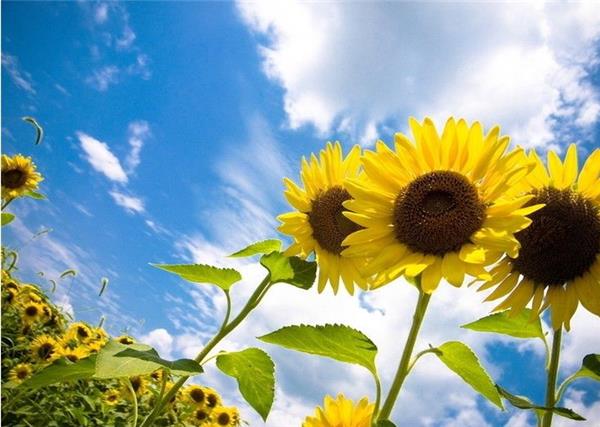When does the sunflower bloom? how to maintain the sunflower?
Sunflowers bloom in a large disk, which should be regarded as the best of all flowers. When the flowering time of sunflowers comes, the golden sea of sunflowers can definitely bring people a magnificent visual experience. In order to make sunflowers blossom and bear fruit as scheduled, more efforts should be made on breeding.

The flowering period of sunflower
The main flowering period of sunflower is from mid-July to mid-and late August. The florescence can reach more than two weeks.
The ligulate flowers of 75% of the plants in the field bloom, that is, the flowering stage. It usually takes 6-9 days for a disk to open from a ligulate flower to a tubular flower. The inflorescence is in full bloom from the second day to the fifth day. The number of flowers in these four days accounted for about 75% of the number of flowers. Most of the flowers bloom from 4 to 6 o'clock in the morning, and the next morning they are pollinated and fertilized. Unfertilized branches can remain intact for 7 or 10 days. The seed setting rate of self-pollination of sunflower is very low, only about 3%, while the seed setting rate of cross-pollination is high.

2. planting methods of dwarf sunflowers
1. Seed selection: the big smile variety of dwarf sunflower is recommended. This variety has a plant height of 30 to 40 meters, a flower diameter of 10 to 17 meters, a bright golden single petal and a black flower heart. It can blossom 50 to 55 days after planting, which is suitable for potted plants and flower beds.
2. Sowing: the seedlings are sowed and propagated, usually in April. The optimum temperature for germination is 15 to 18 ℃, which can be sowed in shallow pots or shallow boxes, with loose media, good water retention, asepsis and so on. It is appropriate to sow on demand, sowing 2 grains per hole and covering 1 to 2 cm thick medium after sowing in order to maintain the humidity needed for germination, increase the stability of seedling stage and reduce the occurrence of shelled seedlings.
3. Cultivation: keep the soil moist when you first plant it. Don't pour too much water after emergence, or the roots will rot. Be careful when watering. When the weather is hot, water it earlier in the morning and later in the evening. After emergence, leave two or three seedlings, more is not conducive to growth.
4. lighting: dwarf sunflowers like the sun, remember to keep enough light, more than 8 hours a day is better! Attention should be paid to the application of sufficient base fertilizer, mainly phosphorus and potassium fertilizer, and light nitrogen fertilizer.
5. Planting and maintenance: when the seedlings come out one after another, one plant is left in each hole, and the seedling height is 7 to 8 meters. The basin soil should be sandy soil which is rich in humus and well drained. When planting, apply sufficient basal fertilizer to the bottom of the basin, and dig up the seedlings with more soil and less root damage, so as to make the plant recover quickly.
6. Fertilization: fertilizing once every 20 days during the growing period, but applying dilute phosphorus and potassium fertilizer 2 or 3 times before flowering. Always keep the soil moist, especially when it is hot and dry in summer. In order to make the terminal bud of the main branch grow and develop healthily, the lateral (axillary) bud can be removed.

III. Maintenance of sunflower blooming period
1. The seed setting rate of self-pollination of sunflower is very low, only about 3%, and the seed setting rate of cross-pollination is high. However, if the temperature is high, Rain Water is more, the humidity is high, the light is insufficient, the soil is dry, the seed setting rate will be greatly reduced; therefore, adjusting the sowing date, timely fertilization and watering, preventing and controlling diseases and insect pests, and taking measures such as bee release or artificial pollination can improve the seed setting rate.
2. From flowering to maturity, spring sowing lasts for 25-55 days and summer sowing for 25-40 days. There are differences among different varieties. About 15 days after flowering and pollination shield is the stage of grain formation. It needs sunny weather, large diurnal liquid temperature difference and suitable soil moisture.
3. In this period, the plant water demand accounts for more than 60% of the lifetime water demand, if the water supply is insufficient, it will cause seed dysplasia and increase the empty shell rate. Therefore, during this period, adequate water supply should be ensured, and proper topdressing combined with watering should be applied with 5kg urea and 10kg diammonium per mu.

After reading the above introduction, do you have more confidence in cultivating sunflowers? I believe that as long as we do the above-mentioned points and pay more attention to planting and maintenance, everyone will be able to make the sunflower bloom as scheduled and produce delicious fruit.
Related
- Wuhan Hospital Iron Tree Blooming Result Was Instantly Frightened by the Gardener Master
- Which variety of camellia is the most fragrant and best? Which one do you like best?
- What is the small blue coat, the breeding methods and matters needing attention of the succulent plant
- Dormancy time and maintenance management of succulent plants during dormancy
- Minas succulent how to raise, Minas succulent plant pictures
- What are the varieties of winter succulent plants
- How to raise succulent plants in twelve rolls? let's take a look at some experience of breeding twelve rolls.
- Attention should be paid to water control for succulent plants during dormant period (winter and summer)
- Watering experience of twelve rolls of succulent plants
- Techniques for fertilizing succulent plants. An article will let you know how to fertilize succulent plants.



